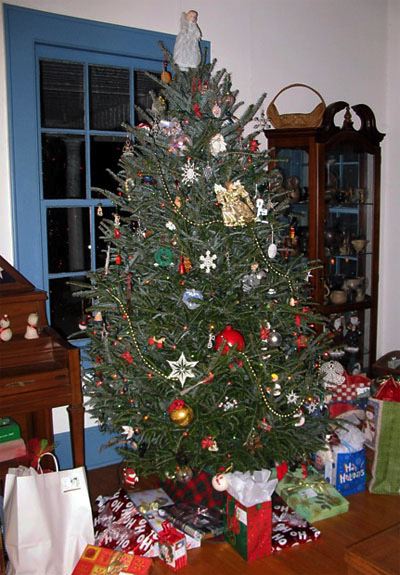|
|
|||
|
THIS WEEK at HILTON POND
23-30 November 2010 Installment #494---Visitor # (Back to Preceding Week; on to Next Week) |
|
SIGN UP FOR 2 OR MORE TRIPS; GET $100 OFF ON EACH Join fellow birders & educators as citizen scientists on 2011 Operation RubyThroat expeditions to observe, capture & band hummingbirds in Belize, Guatemala & Costa Rica. No experience necessary! |
|
All text & photos © Hilton Pond Center FRASER FIR & BALSAM FIR: Through our weekly photo essays we offer intimate glimpses of the natural world, in part to encourage readers to examine their own backyards for plants and creatures they might otherwise overlook. We typically try to avoid controversial topics such as politics, religion, economics, and the like lest we antagonize folks and steer them away from the intent of our nature musings. This week, however, we are coming off Thanksgiving break and a heated discussion we had with a neighbor heading out to cut a tree for the upcoming Christmas season. The neighbor described how he, as a native South Carolinian, had always driven to a Piedmont farm and--with permission of the owner--selected a wild-growing Eastern Red Cedar for his holiday tree. We grew up in Pittsburgh--yes, the Hiltons are "Yinzers" and inveterate fans of the Pirates, Steelers, and Penguins--but in Western Pennsylvania those Eastern Red Cedars, Juniperus virginiana, are few and far between.
The first of these--Balsam Fir--is the holiday foliage we grew up with in Pennsylvania. It's a common northern Appalachian Mountain tree whose range extends from eastern Canada to Alberta; it grows wild and is cultivated extensively on Christmas tree farms throughout the region.
All text & photos © Hilton Pond Center When the Hilton clan eventually moved to Dixie, we still clamored for holiday fir trees, but here in the Carolinas Balsam Fir was not to be found. Instead tree lots (above) carried a genteel southern relative called Fraser Fir--whose shape, needles, and scent were pretty similar and an acceptable substitute. Fraser Fir's range is far more limited than that of Balsam Fir; it occurs naturally only in the Southern Appalachians of north Georgia, North Carolina, Tennessee, Virginia, and extreme southern West Virginia. On these mountaintops it apparently became a new species after being separated from Balsam Fir populations during the last Ice Age.
All text & photos © Hilton Pond Center At high altitudes in the southern mountains (4,500' and above) Fraser Fir grows to more than 80' feet in height, although acid rain and the Balsam Woolly Adelgid, Adelges piceae, introduced from Europe have killed off many towering champion fir trees. (See photo above of "ghost fir" snags on Clingman's Dome in Great Smoky Mountains National Park.) In fact,
All text & photos © Hilton Pond Center Fraser Firs bought at Christmas tree lots almost never have cones on them, but the species obviously must make seeds to reproduce. A mature fir tree actually develops two kinds of cones: Small dangling male ones, and robust cylindrical female cones that stand erect (below left)--sometimes in dense clusters--and that often are tipped or covered with sticky whitish sap. As with most other gymnosperms, the fir cone is made of overlapping scales; between these hide flattened seeds that are dispersed primarily by wind after a cone ripens and scales separate. Fraser Fir foliage is browsed primarily by White-tailed Deer and occasionally by rabbits able to reach low-hanging boughs. The tree's evergreen branches provide important winter shelter for a variety of small mammals and birds--especially during times of heavy snow cover. From a conservation perspective, intermingling roots of Fraser Fir trees on a steep mountainside fulfill a critical role in retarding erosion. And while in an environmental vein, when the holidays are over please don't ever send your decommissioned Christmas tree to the dump. Find a corner of your yard when it can sit quietly for a few years, providing shelter for songbirds and other wildlife before decomposing. We have a magnificent brushpile at Hilton Pond Center that consists of several past years' Fraser Firs that have been taking their time disintegrating. How pleasant it is on a summer day when sun strikes the pile and warms our long-dead Christmas firs enough for their trunks to release some of that sweet-smelling resin . . . .
All text & photos © Hilton Pond Center Another source of Fraser Fir's aroma are its leaves--flattened unstalked needles 0.5" to 1" in length. (Balsam Fir needles are half again as long.) Shiny, blunt-tipped needles grow more or less horizontally from a slightly fuzzy twig (see top photo), maximizing the number of leaves whose photosynthetic surfaces are exposed to sunlight. Surprisingly, an individual Fraser Fir needle may remain alive and functional on a branch for up to five years before dying and leaving the twig with a raised circular scar. Each dark green needle is covered by a waxy compound that helps retard water loss; it's because of the wax that fir trees often glisten in the sunlight. The underside of each fir needle (above, and 5x macro photo below) is marked by two pale white lines. These are lenticels--parallel rows of microscopic pores that allow uptake of carbon dioxide and release of oxygen.
All text & photos © Hilton Pond Center Fraser Firs able to avoid disease and parasites can live at least a century, maybe two. Young trees have smooth bark covered by tiny resin blisters and are relatively resistant to Balsam Woolly Adelgids that prefer older specimens in which the trunk is rough and furrowed. Abies fraseri was discovered by Scottish botanist and explorer John Fraser (1750-1811) who visited the Southern Appalachians and collected the type specimen of the species named for him. He sent seeds back to England, where these days the tree is grown as an ornamental. Why, some Brits even use the Fraser Fir as a Christmas tree! To paraphrase that all-knowing on-line source Wikipedia:
So there you have it. Wikipedia says Fraser Fir is a great Christmas Tree; even the esteemed POTUS (no matter his party affiliation) has used this species more than any other. And the Fraser Fir--unlike Eastern Red Cedars that we know first-hand can scratch and cause unpleasant dermatitis--has non-pricking needles. That's all the rationale we need to disagree once more with our neighbor by proclaiming with great assurance the Fraser Fir and its equally aromatic northern cousin Balsam Fir are the only "true" Christmas trees. Since this is a truism, you'd be right in guessing any tree in the old farmhouse at Hilton Pond Center will always be a near-perfect specimen of Abies fraseri, fresh-cut in the North Carolina mountains and picked out special to share with friends and family during the upcoming holiday season.
All text & photos © Hilton Pond Center If you have a Twitter account and liked this page, you can recommend "This Week at Hilton Pond" to your followers by clicking on the Tweet button: Tweet Follow us on Twitter: @hiltonpond
|


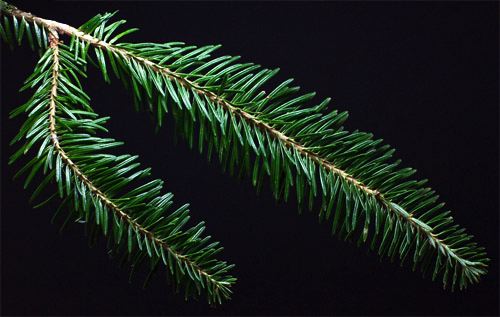
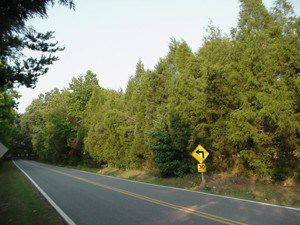 We innocently suggested the cedar was far too common a roadside plant (right) to be brought indoors and decorated at Christmastime and described how for generations the Hilton family has ALWAYS opted for a fir. At this point the neighbor turned red as Rudolph's nose, literally snorted and stamped his foot, and adamantly claimed we didn't know what we were talking about--especially after we said we really do like red cedars but didn't think they belonged in the house. Not realizing a discussion about Christmas tree preferences would generate such an agitated response in our neighbor, we eased our way out of the conversation and headed back to Hilton Pond Center--but not before the neighbor shouted out with passionate conviction that "Red cedars are the only true Christmas trees." Alas--and we say this with an understanding our readership may take issue over such a pronouncement--the neighbor was wrong. The fir is the ONLY true Christmas tree.
We innocently suggested the cedar was far too common a roadside plant (right) to be brought indoors and decorated at Christmastime and described how for generations the Hilton family has ALWAYS opted for a fir. At this point the neighbor turned red as Rudolph's nose, literally snorted and stamped his foot, and adamantly claimed we didn't know what we were talking about--especially after we said we really do like red cedars but didn't think they belonged in the house. Not realizing a discussion about Christmas tree preferences would generate such an agitated response in our neighbor, we eased our way out of the conversation and headed back to Hilton Pond Center--but not before the neighbor shouted out with passionate conviction that "Red cedars are the only true Christmas trees." Alas--and we say this with an understanding our readership may take issue over such a pronouncement--the neighbor was wrong. The fir is the ONLY true Christmas tree. The species does get into the Keystone State but mostly in eastern sections, so for us who grew up in Pittsburgh the smell of red cedar still drums up memories not of Christmas but of summertime visits to relatives who lived "down south" in Carolina. Indeed, to us the real odor of the winter holiday season is that of the fir, the tree of preference for our father Bill Hilton Sr., his father, and his father's father and even for his mother's father and his own descendants. All these gentlemen and their families knew in their hearts that to properly celebrate Christmas each year one must find the perfect tree, which was ALWAYS a fir.
The species does get into the Keystone State but mostly in eastern sections, so for us who grew up in Pittsburgh the smell of red cedar still drums up memories not of Christmas but of summertime visits to relatives who lived "down south" in Carolina. Indeed, to us the real odor of the winter holiday season is that of the fir, the tree of preference for our father Bill Hilton Sr., his father, and his father's father and even for his mother's father and his own descendants. All these gentlemen and their families knew in their hearts that to properly celebrate Christmas each year one must find the perfect tree, which was ALWAYS a fir.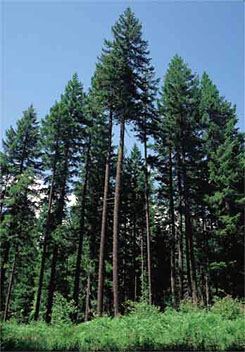 North America is host to several fir species, and there are actually two fir genera on the continent. Douglas Firs (right), Pseudotsuga menziesii, are tall evergreens of the Rockies and far western states. They're abundant and very important timber trees, but they're separate from the nine kinds of True Firs, Abies spp., of which seven kinds occur only in the west. That leaves just two eastern varieties of firs: Balsam Fir, Abies balsamea, and Fraser Fir, A. fraseri.
North America is host to several fir species, and there are actually two fir genera on the continent. Douglas Firs (right), Pseudotsuga menziesii, are tall evergreens of the Rockies and far western states. They're abundant and very important timber trees, but they're separate from the nine kinds of True Firs, Abies spp., of which seven kinds occur only in the west. That leaves just two eastern varieties of firs: Balsam Fir, Abies balsamea, and Fraser Fir, A. fraseri.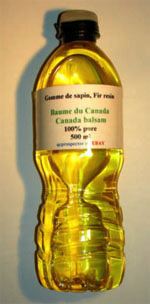 Balsam Fir is a moisture-loving plant that often sprouts beneath a canopy of spruces, Trembling Aspen, and Paper Birch that in combination cast enough shade to severely stunt the fir's growth. When a canopy tree dies, however, a Balsam Fir sapling grows rapidly toward the light, taking only a few years to fill what we call the "hole in the sky." Like its congeners, Balsam Fir produces prodigious amounts of sticky sap--one of the sources of the heavenly fragrance that always filled our Pittsburgh household at Christmastime. In addition to having a fine, pungent aroma, the pale yellow resin of Balsam Fir (bottled, above left) is "optically pure" and has the same refractive index as glass. This latter characteristic--along with the fact "Canada Balsam" is quite viscous and dries into a hard glue that doesn't crystallize or fragment--makes it an ideal mounting medium for permanent microscope slides. It follows that during our undergraduate biology career the aroma of our microscopy labs always reminded us of Christmas.
Balsam Fir is a moisture-loving plant that often sprouts beneath a canopy of spruces, Trembling Aspen, and Paper Birch that in combination cast enough shade to severely stunt the fir's growth. When a canopy tree dies, however, a Balsam Fir sapling grows rapidly toward the light, taking only a few years to fill what we call the "hole in the sky." Like its congeners, Balsam Fir produces prodigious amounts of sticky sap--one of the sources of the heavenly fragrance that always filled our Pittsburgh household at Christmastime. In addition to having a fine, pungent aroma, the pale yellow resin of Balsam Fir (bottled, above left) is "optically pure" and has the same refractive index as glass. This latter characteristic--along with the fact "Canada Balsam" is quite viscous and dries into a hard glue that doesn't crystallize or fragment--makes it an ideal mounting medium for permanent microscope slides. It follows that during our undergraduate biology career the aroma of our microscopy labs always reminded us of Christmas.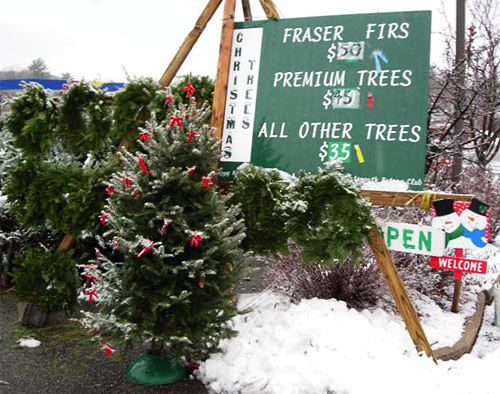
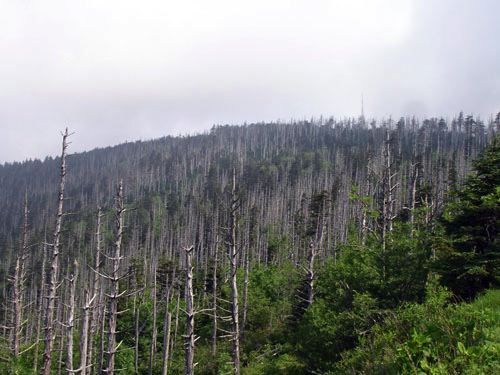
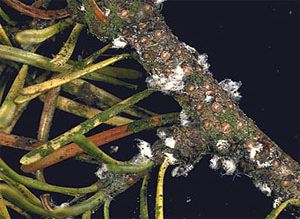 some ecologists think the only sure hope for saving the species is the plethora of Fraser Fir plantations (below) that have sprung up, particularly in North Carolina; farmers there keep a close eye on their economically valuable trees and try to eradicate insects when they occur. One likely reason wingless adelgids (above right) have become such a problem is that populations of migrant Neotropical warblers--which can glean huge numbers of tiny insects within a fir stand--have declined significantly in recent decades. Climate change also may be playing a role by reducing viability of cold-loving Fraser Fir.
some ecologists think the only sure hope for saving the species is the plethora of Fraser Fir plantations (below) that have sprung up, particularly in North Carolina; farmers there keep a close eye on their economically valuable trees and try to eradicate insects when they occur. One likely reason wingless adelgids (above right) have become such a problem is that populations of migrant Neotropical warblers--which can glean huge numbers of tiny insects within a fir stand--have declined significantly in recent decades. Climate change also may be playing a role by reducing viability of cold-loving Fraser Fir.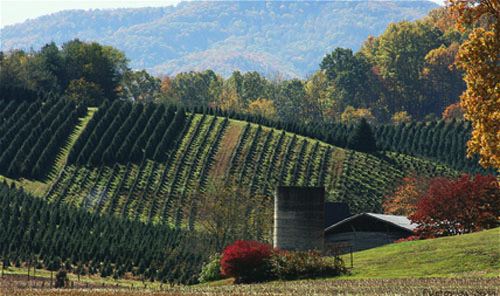
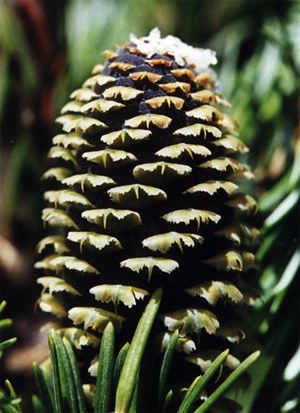 The fir's dry, papery seeds are a staple for birds such as chickadees, jays, crossbills, and grouse, and for squirrels, chipmunks, and mice.
The fir's dry, papery seeds are a staple for birds such as chickadees, jays, crossbills, and grouse, and for squirrels, chipmunks, and mice. 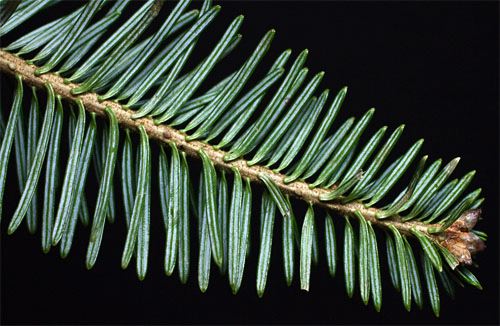
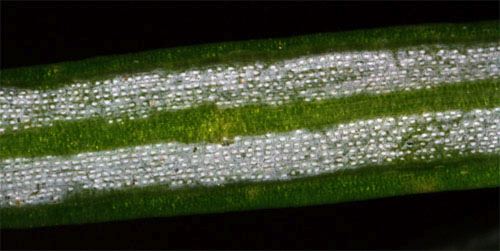
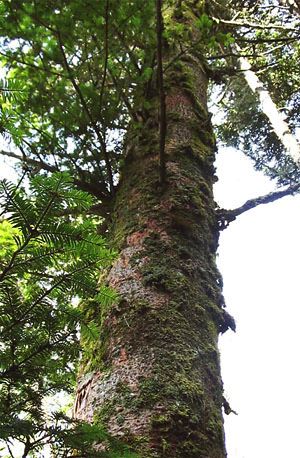 Healthy, mature trees in humid, shady habitats (right) often have trunks and main branches shrouded with dense colonies of mosses and crustose, foliose, and/or fruticose lichens, giving the fir stand a mysterious look--especially on foggy days. Fraser Fir, like its northern relative, is occasionally harvested by the pulp and paper industry; otherwise, its wood is soft and lightweight but is easily worked and takes a fine finish suitable for interior trim.
Healthy, mature trees in humid, shady habitats (right) often have trunks and main branches shrouded with dense colonies of mosses and crustose, foliose, and/or fruticose lichens, giving the fir stand a mysterious look--especially on foggy days. Fraser Fir, like its northern relative, is occasionally harvested by the pulp and paper industry; otherwise, its wood is soft and lightweight but is easily worked and takes a fine finish suitable for interior trim.